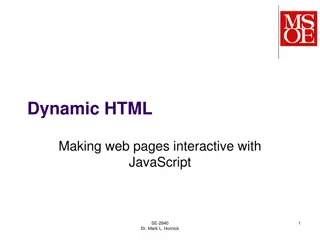Exploring Web Application Vulnerabilities and JavaScript Worms
Web applications face pervasive vulnerabilities, with Cross-site Scripting (XSS) leading the threats. The domination of XSS and buffer overruns has enabled the propagation of JavaScript worms, exemplified by infamous cases like Samy's MySpace outbreak. These exploits, marked by obfuscation and polymorphism, pose challenges to traditional signature-based solutions. The evolving landscape of web security demands a deeper understanding of XSS holes and proactive mitigation strategies.
Download Presentation

Please find below an Image/Link to download the presentation.
The content on the website is provided AS IS for your information and personal use only. It may not be sold, licensed, or shared on other websites without obtaining consent from the author.If you encounter any issues during the download, it is possible that the publisher has removed the file from their server.
You are allowed to download the files provided on this website for personal or commercial use, subject to the condition that they are used lawfully. All files are the property of their respective owners.
The content on the website is provided AS IS for your information and personal use only. It may not be sold, licensed, or shared on other websites without obtaining consent from the author.
E N D
Presentation Transcript
Ben Livshits and Weidong Cui Microsoft Research Redmond, WA
Web application vulnerabilities are everywhere Cross-site scripting (XSS) Dominates the charts Buffer overruns of this decade Key enabler of JavaScript worms 2
Unleashed by Samy as a proof-of- concept in October 2005 Worm name Type of site Release date Samy/MySpace Social networking Oct-05 xanga.com Social networking Dec-05 SpaceFlash/MySpace Social networking Jul-06 Yamanner/Yahoo! Mail Email service Jun-06 QSpace/MySpace Social networking Nov-06 adultspace.com Social networking Dec-06 gaiaonline.com Online gaming Jan-07 u-dominion.com Online gaming Jan-07 3
Samy took down MySpace (October 2005) Site couldn t cope: down for two days Came down after 13 hours Cleanup costs Yamanner (Yahoo mail) worm (June 2006) Sent malicious HTML mail to users in the current user s address book Affected 200,000 users, emails used for spamming 4
Initial infection: Samy s MySpace page Injected JavaScript payload exploits a XSS hole Propagation step: User views an infected page Payload executes Adds Samy as friend Add payload to user s page 5
Worms of the previous decade enabled by buffer overruns JavaScript worms are enabled by cross-site scripting (XSS) Fixing XSS holes is best, but some vulnerabilities remain The month of MySpace bugs Database of XSS vulnerabilities: xssed.com 6
Existing solutions rely on signatures Ineffective: obfuscated and polymorphic JavaScript worms are very easy to write Most real-life worms are obfuscated Fundamental difficulties Servercan t tell a user request from worm activity Browserdoesn t know where JavaScript comes from 7
u1 uploads to his page u2 downloads page of u1 u2 uploads to his page u3 downloads page of u2 u3 uploads to his page payload u1 u2 u3 Propagation chain 1. Preserve causality of uploads, store as a graph 2. Detect long propagation chains 3. Report them as potential worm outbreaks
Spectator proxy page page Server-side application Client-side tracking tag tag1 -> tag2 U1 U2 request request tag 11
Tagging of uploaded input <div spectator_tag=56> <div> <b onclick="javascript:alert( ... )">...</b> </div> Client-side request tracking Injected JavaScript and response headers Propagates causality information through cookies on the client side 12
Propagation graph G: Records causality between tags (content uploads) Records IP address (approximation of user) with each Worm: Diameter(G) > threshold d <t9, ip0> <t3, ip0> <t7, ip0><t8, ip0> <t5, ip0> <t0, ip0> <t1, ip1><t2, ip0> <t6, ip0> <t4, ip2> 13
Determining diameter precisely is exponential Scalability is crucial Thousands of users Millions of uploads Use greedy approximation of the diameter instead Precise algorithm O(2n) O(n) Approximate algorithm Upload insertion time Upload insertion space O(1) on average O(n) Worm containment time O(n) O(n) 14
Large-scale simulation with OurSpace: Mimics a social networking site like MySpace Experimented with various patterns of site access Looked at the scalability Real-life case study: Uses Siteframe, a third-party social networking app Developed a JavaScript worm for it similar to real-life ones 16
Test-bed: OurSpace Every user has their own page At any point, a user can read or write to a page Write(U1, hello ); Write(U1, Read(U2)); Write(U3, Read(U1)); Various access scenarios: Scenario 1: Worm outbreak (random topology) Scenario 2: A single long blog entry Scenario 3: A power law model of worm propagation 17
Real-life worm experimentation is difficult Used Siteframe, open-source blogging system Found an exploitable XSS Developed a worm for it Scripted user behavior Spectator flags the worm 20
First defense against JavaScript worms Fast and slow, mono- and polymorphic worms Scales well with low overhead Essence of the approach Perform distributed data tainting Look for long propagation chains Demonstrated scalability and effectiveness 21























